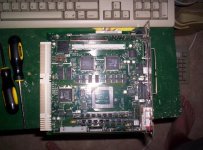Both LEM (http://lowendmac.com/quadra/lc-630-ram-expansion.html) and AppleFritter (http://www.applefritter.com/node/24415) refer to the solder pads on some versions of the Quadra/Performa/LC 630 logic board as taking another 72pin SIMM slot.
On my board, I see the solder pads, but there are only 64 pads, and in a much shorter configuration than the neighboring 72 pin slot. They don't seem to be setup to accept a 72 pin SIMM socket as these resources suggest.
So, does anyone here know what they are for? Am I misinterpreting these posts or the board?
Thanks
On my board, I see the solder pads, but there are only 64 pads, and in a much shorter configuration than the neighboring 72 pin slot. They don't seem to be setup to accept a 72 pin SIMM socket as these resources suggest.
So, does anyone here know what they are for? Am I misinterpreting these posts or the board?
Thanks



